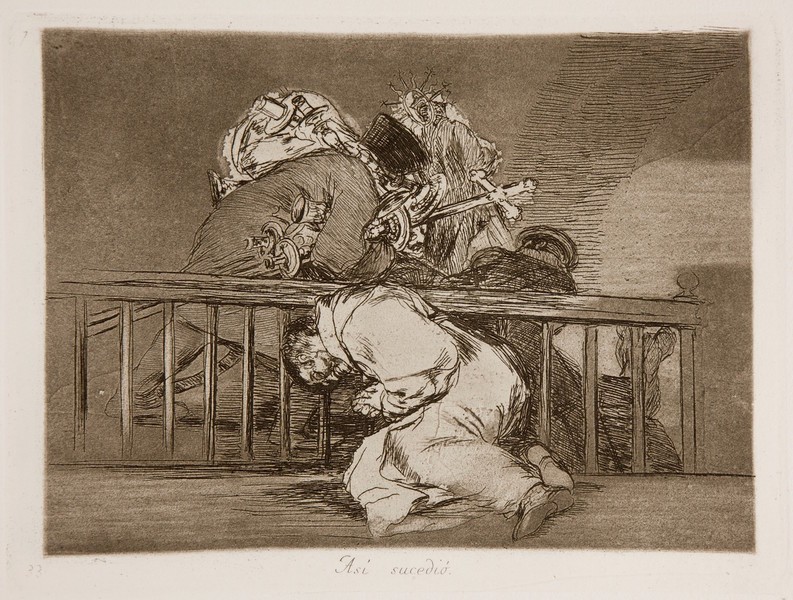- Cronología
- Ca. 1812 - 1815
- Dimensiones
- 156 x 209 mm
- Técnica y soporte
- Aguafuerte, punta seca, buril, lavis bruñido y bruñidor
- Reconocimiento de la autoría de Goya
- Undisputed work
- Ficha: realización/revisión
- 15 Dec 2010 / 02 Jun 2023
- Inventario
- 225
33 (on the lower left-hand corner of the plate).
See Sad presentiments of what must come to pass.
The second artist's proof reveals the use of burnished lavis up to the edges of the plate and drypoint to render the soldiers and the icon that they are carrying between them. The left-hand shoulder of the soldier on the right has been retouched in burin.
The title was handwritten on the print by Goya in the first and only series that is known to have been printed at the time the works were created, which the artist gave to his friend Agustín Ceán Bermúdez. Therefore, the title was etched into the plate at a later date and left unchanged as of the first edition of the Disasters of War printed by the San Fernando Royal Academy of Fine Arts in Madrid in 1863, after the printing of the series in the possession of Ceán Bermúdez.
There are no surviving preparatory drawings for this print.
In a dark setting featuring an arch, perhaps of the vestry of a church, some French soldiers are taking flight having stolen some objects of value from the building. One of the soldiers in the foreground whose face is turned away from the viewer is carrying the image of the Virgin Mary, a processional cross and four candlesticks. The thieves leave behind them a seriously injured monk - possibly of the Franciscan order - who kneels before the soldiers, doubled over in terrible pain. He seems to be clasping a knife not visible to the viewer as it is covered by his hands.
The artist has expressed the darkness of the scene by covering the plate with a fine layer of aquatint that has been burnished to light up certain areas, producing a soft texture. The effect achieved with the aquatint means that the lines created with burin seem more violent.
As in the case of the previous print in the series, no. 46, This is bad (Esto es malo), Goya openly criticises the acts of brutal violence that were carried out on the members of some religious orders in times of war and were often recorded in statements and public notices. In this image, rather than fleeing the monk remains in the church, risking his life to defend the sacred objects stored there. In this work Goya employs the same formal device used in print no. 46: the creation of a very dark setting highlights the deplorable behaviour of the French soldiers, who act under the cover of darkness. The artist has made the monk's white habit shine out of this darkness, thereby emphasizing the religious man's innocence.
The sacking of Cuenca, which took place on 17 June 1808, was reported in the Gazeta de Madrid on 5 September of that year. The pillage took place at night: the French soldiers robbed houses and looted monasteries, charitable institutions and churches, stealing treasure and defacing sacred icons. These anticlerical gestures led a section of the ecclesiastical hierarchy to identify an opportunity to portray the war as a new crusade.
The plate is stored in the National Chalcography (cat. 298) .
-
Goya. Drawings, Etchings and LithographsGoya. DrawingsLondon1954from June 12th to July 25th 1954pp. 8-10, cat. 62
-
Goya. Das Zeitalter der Revolucionen. Kunst um 1800 (1980 – 1981)Hamburger KunsthalleHamburg1980cat. 90
-
Goya y el espíritu de la IlustraciónMuseo Nacional del PradoMadrid1988from October 6th to December 18th 1988. Exhibited also at Museum of Fine Arts, Boston, January 18th to March 26th 1989; The Metropolitan Museum of Art, Nueva York, May 9th to July 16th 1989, Madrid curator Manuela B. Mena Marqués, scientific directors Alfonso E. Pérez Sánchez and Eleanor A. Sayrecat. 90
-
Francisco de GoyaMuseo d'Arte ModernaLugano1996exhibition celebrated from September 22nd to November 17th.p. 164, cat. 47
-
Francisco Goya. Sein leben im spiegel der graphik. Fuendetodos 1746-1828 Bordeaux. 1746-1996Galerie KornfeldBern1996from November 21st 1996 to January 1997cat. 131
-
Ydioma universal: Goya en la Biblioteca NacionalBiblioteca NacionalMadrid1996from September 19th to December 15th 1996cat. 226
-
Francisco Goya. Capricci, follie e disastri della guerraSan Donato Milanese2000Opere grafiche della Fondazione Antonio Mazzottacat. 127
-
Goya. Opera graficaPinacoteca del Castello di San GiorgioLegnano2006exhibition celebrated from December 16th 2006 to April 1st 2007p. 74
-
Goya et la modernitéPinacothèque de ParisParís2013from October 11st 2013 to March 16th 2014cat. 86
-
Goya: Order and disorderMuseum of Fine ArtsBoston2014cat. 197
-
Goya, grabadorMadridBlass S.A.1918cat. 149
-
Goya engravings and lithographs, vol. I y II.OxfordBruno Cassirer1964cat. 167
-
Vie et ouvre de Francisco de GoyaParísOffice du livre1970cat. 1069
-
Goya y el espíritu de la IlustraciónMadridMuseo del Prado1988pp. 307-308, cat. 90
-
Catálogo de las estampas de Goya en la Biblioteca NacionalMadridMinisterio de Educación y Cultura, Biblioteca Nacional1996cat. 256
-
ParísPinacoteca de París2013p. 143
-
Goya: Order & DisorderBostonMuseum of Fine Arts Boston Publications2014p. 291
-
Goya. In the Norton Simon MuseumPasadenaNorton Simon Museum2016pp. 114-151
